SpringCloud+SpringBoot+OAuth2+Spring Security+Redis实现的微服务统一认证授权
共 34939字,需浏览 70分钟
· 2021-10-26

Windows10 Intellij Idea2018.2 jdk1.8 redis3.2.9 Spring Boot 2.0.2 Release Spring Cloud Finchley.RC2 Spring 5.0.6
项目目录
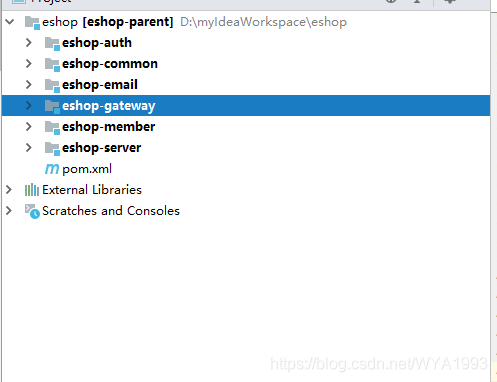
eshop —— 父级工程,管理jar包版本
eshop-server —— Eureka服务注册中心 eshop-gateway —— Zuul网关 eshop-auth —— 授权服务 eshop-member —— 会员服务 eshop-email —— 邮件服务(暂未使用) eshop-common —— 通用类
授权服务
首先构建eshop-auth服务,引入相关依赖
xml version="1.0" encoding="UTF-8"?>
<project xmlns="http://maven.apache.org/POM/4.0.0"
xmlns:xsi="http://www.w3.org/2001/XMLSchema-instance"
xsi:schemaLocation="http://maven.apache.org/POM/4.0.0 http://maven.apache.org/xsd/maven-4.0.0.xsd">
<parent>
<artifactId>eshop-parentartifactId>
<groupId>com.curise.eshopgroupId>
<version>1.0-SNAPSHOTversion>
parent>
<modelVersion>4.0.0modelVersion>
<artifactId>eshop-authartifactId>
<packaging>warpackaging>
<description>授权模块description>
<dependencies>
<dependency>
<groupId>com.curise.eshopgroupId>
<artifactId>eshop-commonartifactId>
<version>1.0-SNAPSHOTversion>
dependency>
<dependency>
<groupId>org.springframework.bootgroupId>
<artifactId>spring-boot-starter-webartifactId>
dependency>
<dependency>
<groupId>org.springframework.cloudgroupId>
<artifactId>spring-cloud-starter-netflix-eureka-clientartifactId>
dependency>
<dependency>
<groupId>org.springframework.cloudgroupId>
<artifactId>spring-cloud-starter-oauth2artifactId>
dependency>
<dependency>
<groupId>org.springframework.cloudgroupId>
<artifactId>spring-cloud-starter-securityartifactId>
dependency>
<dependency>
<groupId>org.springframework.bootgroupId>
<artifactId>spring-boot-starter-data-redisartifactId>
dependency>
<dependency>
<groupId>org.mybatis.spring.bootgroupId>
<artifactId>mybatis-spring-boot-starterartifactId>
dependency>
<dependency>
<groupId>org.springframework.bootgroupId>
<artifactId>spring-boot-starter-actuatorartifactId>
dependency>
<dependency>
<groupId>mysqlgroupId>
<artifactId>mysql-connector-javaartifactId>
dependency>
<dependency>
<groupId>com.alibabagroupId>
<artifactId>druidartifactId>
dependency>
<dependency>
<groupId>log4jgroupId>
<artifactId>log4jartifactId>
dependency>
dependencies>
<build>
<plugins>
<plugin>
<groupId>org.springframework.bootgroupId>
<artifactId>spring-boot-maven-pluginartifactId>
plugin>
plugins>
build>
project>接下来,配置Mybatis、redis、eureka,贴一下配置文件
server:
port: 1203
spring:
application:
name: eshop-auth
redis:
database: 0
host: 192.168.0.117
port: 6379
password:
jedis:
pool:
max-active: 8
max-idle: 8
min-idle: 0
datasource:
driver-class-name: com.mysql.jdbc.Driver
url: jdbc:mysql://localhost:3306/eshop_member?useUnicode=true&characterEncoding=utf-8&useSSL=false&allowMultiQueries=true
username: root
password: root
druid:
initialSize: 5 #初始化连接大小
minIdle: 5 #最小连接池数量
maxActive: 20 #最大连接池数量
maxWait: 60000 #获取连接时最大等待时间,单位毫秒
timeBetweenEvictionRunsMillis: 60000 #配置间隔多久才进行一次检测,检测需要关闭的空闲连接,单位是毫秒
minEvictableIdleTimeMillis: 300000 #配置一个连接在池中最小生存的时间,单位是毫秒
validationQuery: SELECT 1 from DUAL #测试连接
testWhileIdle: true #申请连接的时候检测,建议配置为true,不影响性能,并且保证安全性
testOnBorrow: false #获取连接时执行检测,建议关闭,影响性能
testOnReturn: false #归还连接时执行检测,建议关闭,影响性能
poolPreparedStatements: false #是否开启PSCache,PSCache对支持游标的数据库性能提升巨大,oracle建议开启,mysql下建议关闭
maxPoolPreparedStatementPerConnectionSize: 20 #开启poolPreparedStatements后生效
filters: stat,wall,log4j #配置扩展插件,常用的插件有=>stat:监控统计 log4j:日志 wall:防御sql注入
connectionProperties: 'druid.stat.mergeSql=true;druid.stat.slowSqlMillis=5000' #通过connectProperties属性来打开mergeSql功能;慢SQL记录
eureka:
instance:
prefer-ip-address: true
instance-id: ${spring.cloud.client.ip-address}:${server.port}
client:
service-url:
defaultZone: http://localhost:1111/eureka/
mybatis:
type-aliases-package: com.curise.eshop.common.entity
configuration:
map-underscore-to-camel-case: true #开启驼峰命名,l_name -> lName
jdbc-type-for-null: NULL
lazy-loading-enabled: true
aggressive-lazy-loading: true
cache-enabled: true #开启二级缓存
call-setters-on-nulls: true #map空列不显示问题
mapper-locations:
- classpath:mybatis/*.xmlAuthApplication添加@EnableDiscoveryClient和@MapperScan注解。
@Configuration
@EnableAuthorizationServer
public class AuthorizationServerConfig extends AuthorizationServerConfigurerAdapter {
@Autowired
private AuthenticationManager authenticationManager;
@Autowired
private DataSource dataSource;
@Autowired
private RedisConnectionFactory redisConnectionFactory;
@Autowired
private MyUserDetailService userDetailService;
@Bean
public TokenStore tokenStore() {
return new RedisTokenStore(redisConnectionFactory);
}
@Override
public void configure(AuthorizationServerSecurityConfigurer security) throws Exception {
security
.allowFormAuthenticationForClients()
.tokenKeyAccess("permitAll()")
.checkTokenAccess("isAuthenticated()");
}
@Override
public void configure(ClientDetailsServiceConfigurer clients) throws Exception {
// clients.withClientDetails(clientDetails());
clients.inMemory()
.withClient("android")
.scopes("read")
.secret("android")
.authorizedGrantTypes("password", "authorization_code", "refresh_token")
.and()
.withClient("webapp")
.scopes("read")
.authorizedGrantTypes("implicit")
.and()
.withClient("browser")
.authorizedGrantTypes("refresh_token", "password")
.scopes("read");
}
@Bean
public ClientDetailsService clientDetails() {
return new JdbcClientDetailsService(dataSource);
}
@Bean
public WebResponseExceptionTranslator webResponseExceptionTranslator(){
return new MssWebResponseExceptionTranslator();
}
@Override
public void configure(AuthorizationServerEndpointsConfigurer endpoints) throws Exception {
endpoints.tokenStore(tokenStore())
.userDetailsService(userDetailService)
.authenticationManager(authenticationManager);
endpoints.tokenServices(defaultTokenServices());
//认证异常翻译
// endpoints.exceptionTranslator(webResponseExceptionTranslator());
}
/**
* 注意,自定义TokenServices的时候,需要设置@Primary,否则报错,
* @return
*/
@Primary
@Bean
public DefaultTokenServices defaultTokenServices(){
DefaultTokenServices tokenServices = new DefaultTokenServices();
tokenServices.setTokenStore(tokenStore());
tokenServices.setSupportRefreshToken(true);
//tokenServices.setClientDetailsService(clientDetails());
// token有效期自定义设置,默认12小时
tokenServices.setAccessTokenValiditySeconds(60*60*12);
// refresh_token默认30天
tokenServices.setRefreshTokenValiditySeconds(60 * 60 * 24 * 7);
return tokenServices;
}
}nested exception is java.lang.NoSuchMethodError: org.springframework.data.redis.connection.RedisConnection.set([B[B)Vpublic class RedisTokenStore implements TokenStore {
private static final String ACCESS = "access:";
private static final String AUTH_TO_ACCESS = "auth_to_access:";
private static final String AUTH = "auth:";
private static final String REFRESH_AUTH = "refresh_auth:";
private static final String ACCESS_TO_REFRESH = "access_to_refresh:";
private static final String REFRESH = "refresh:";
private static final String REFRESH_TO_ACCESS = "refresh_to_access:";
private static final String CLIENT_ID_TO_ACCESS = "client_id_to_access:";
private static final String UNAME_TO_ACCESS = "uname_to_access:";
private final RedisConnectionFactory connectionFactory;
private AuthenticationKeyGenerator authenticationKeyGenerator = new DefaultAuthenticationKeyGenerator();
private RedisTokenStoreSerializationStrategy serializationStrategy = new JdkSerializationStrategy();
private String prefix = "";
public RedisTokenStore(RedisConnectionFactory connectionFactory) {
this.connectionFactory = connectionFactory;
}
public void setAuthenticationKeyGenerator(AuthenticationKeyGenerator authenticationKeyGenerator) {
this.authenticationKeyGenerator = authenticationKeyGenerator;
}
public void setSerializationStrategy(RedisTokenStoreSerializationStrategy serializationStrategy) {
this.serializationStrategy = serializationStrategy;
}
public void setPrefix(String prefix) {
this.prefix = prefix;
}
private RedisConnection getConnection() {
return this.connectionFactory.getConnection();
}
private byte[] serialize(Object object) {
return this.serializationStrategy.serialize(object);
}
private byte[] serializeKey(String object) {
return this.serialize(this.prefix + object);
}
private OAuth2AccessToken deserializeAccessToken(byte[] bytes) {
return (OAuth2AccessToken)this.serializationStrategy.deserialize(bytes, OAuth2AccessToken.class);
}
private OAuth2Authentication deserializeAuthentication(byte[] bytes) {
return (OAuth2Authentication)this.serializationStrategy.deserialize(bytes, OAuth2Authentication.class);
}
private OAuth2RefreshToken deserializeRefreshToken(byte[] bytes) {
return (OAuth2RefreshToken)this.serializationStrategy.deserialize(bytes, OAuth2RefreshToken.class);
}
private byte[] serialize(String string) {
return this.serializationStrategy.serialize(string);
}
private String deserializeString(byte[] bytes) {
return this.serializationStrategy.deserializeString(bytes);
}
@Override
public OAuth2AccessToken getAccessToken(OAuth2Authentication authentication) {
String key = this.authenticationKeyGenerator.extractKey(authentication);
byte[] serializedKey = this.serializeKey(AUTH_TO_ACCESS + key);
byte[] bytes = null;
RedisConnection conn = this.getConnection();
try {
bytes = conn.get(serializedKey);
} finally {
conn.close();
}
OAuth2AccessToken accessToken = this.deserializeAccessToken(bytes);
if (accessToken != null) {
OAuth2Authentication storedAuthentication = this.readAuthentication(accessToken.getValue());
if (storedAuthentication == null || !key.equals(this.authenticationKeyGenerator.extractKey(storedAuthentication))) {
this.storeAccessToken(accessToken, authentication);
}
}
return accessToken;
}
@Override
public OAuth2Authentication readAuthentication(OAuth2AccessToken token) {
return this.readAuthentication(token.getValue());
}
@Override
public OAuth2Authentication readAuthentication(String token) {
byte[] bytes = null;
RedisConnection conn = this.getConnection();
try {
bytes = conn.get(this.serializeKey("auth:" + token));
} finally {
conn.close();
}
OAuth2Authentication auth = this.deserializeAuthentication(bytes);
return auth;
}
@Override
public OAuth2Authentication readAuthenticationForRefreshToken(OAuth2RefreshToken token) {
return this.readAuthenticationForRefreshToken(token.getValue());
}
public OAuth2Authentication readAuthenticationForRefreshToken(String token) {
RedisConnection conn = getConnection();
try {
byte[] bytes = conn.get(serializeKey(REFRESH_AUTH + token));
OAuth2Authentication auth = deserializeAuthentication(bytes);
return auth;
} finally {
conn.close();
}
}
@Override
public void storeAccessToken(OAuth2AccessToken token, OAuth2Authentication authentication) {
byte[] serializedAccessToken = serialize(token);
byte[] serializedAuth = serialize(authentication);
byte[] accessKey = serializeKey(ACCESS + token.getValue());
byte[] authKey = serializeKey(AUTH + token.getValue());
byte[] authToAccessKey = serializeKey(AUTH_TO_ACCESS + authenticationKeyGenerator.extractKey(authentication));
byte[] approvalKey = serializeKey(UNAME_TO_ACCESS + getApprovalKey(authentication));
byte[] clientId = serializeKey(CLIENT_ID_TO_ACCESS + authentication.getOAuth2Request().getClientId());
RedisConnection conn = getConnection();
try {
conn.openPipeline();
conn.stringCommands().set(accessKey, serializedAccessToken);
conn.stringCommands().set(authKey, serializedAuth);
conn.stringCommands().set(authToAccessKey, serializedAccessToken);
if (!authentication.isClientOnly()) {
conn.rPush(approvalKey, serializedAccessToken);
}
conn.rPush(clientId, serializedAccessToken);
if (token.getExpiration() != null) {
int seconds = token.getExpiresIn();
conn.expire(accessKey, seconds);
conn.expire(authKey, seconds);
conn.expire(authToAccessKey, seconds);
conn.expire(clientId, seconds);
conn.expire(approvalKey, seconds);
}
OAuth2RefreshToken refreshToken = token.getRefreshToken();
if (refreshToken != null && refreshToken.getValue() != null) {
byte[] refresh = serialize(token.getRefreshToken().getValue());
byte[] auth = serialize(token.getValue());
byte[] refreshToAccessKey = serializeKey(REFRESH_TO_ACCESS + token.getRefreshToken().getValue());
conn.stringCommands().set(refreshToAccessKey, auth);
byte[] accessToRefreshKey = serializeKey(ACCESS_TO_REFRESH + token.getValue());
conn.stringCommands().set(accessToRefreshKey, refresh);
if (refreshToken instanceof ExpiringOAuth2RefreshToken) {
ExpiringOAuth2RefreshToken expiringRefreshToken = (ExpiringOAuth2RefreshToken) refreshToken;
Date expiration = expiringRefreshToken.getExpiration();
if (expiration != null) {
int seconds = Long.valueOf((expiration.getTime() - System.currentTimeMillis()) / 1000L)
.intValue();
conn.expire(refreshToAccessKey, seconds);
conn.expire(accessToRefreshKey, seconds);
}
}
}
conn.closePipeline();
} finally {
conn.close();
}
}
private static String getApprovalKey(OAuth2Authentication authentication) {
String userName = authentication.getUserAuthentication() == null ? "": authentication.getUserAuthentication().getName();
return getApprovalKey(authentication.getOAuth2Request().getClientId(), userName);
}
private static String getApprovalKey(String clientId, String userName) {
return clientId + (userName == null ? "" : ":" + userName);
}
@Override
public void removeAccessToken(OAuth2AccessToken accessToken) {
this.removeAccessToken(accessToken.getValue());
}
@Override
public OAuth2AccessToken readAccessToken(String tokenValue) {
byte[] key = serializeKey(ACCESS + tokenValue);
byte[] bytes = null;
RedisConnection conn = getConnection();
try {
bytes = conn.get(key);
} finally {
conn.close();
}
OAuth2AccessToken accessToken = deserializeAccessToken(bytes);
return accessToken;
}
public void removeAccessToken(String tokenValue) {
byte[] accessKey = serializeKey(ACCESS + tokenValue);
byte[] authKey = serializeKey(AUTH + tokenValue);
byte[] accessToRefreshKey = serializeKey(ACCESS_TO_REFRESH + tokenValue);
RedisConnection conn = getConnection();
try {
conn.openPipeline();
conn.get(accessKey);
conn.get(authKey);
conn.del(accessKey);
conn.del(accessToRefreshKey);
// Don't remove the refresh token - it's up to the caller to do that
conn.del(authKey);
List配置资源服务器
@Configuration
@EnableResourceServer
@Order(3)
public class ResourceServerConfig extends ResourceServerConfigurerAdapter {
@Override
public void configure(HttpSecurity http) throws Exception {
http
.csrf().disable()
.exceptionHandling()
.authenticationEntryPoint((request, response, authException) -> response.sendError(HttpServletResponse.SC_UNAUTHORIZED))
.and()
.requestMatchers().antMatchers("/api/**")
.and()
.authorizeRequests()
.antMatchers("/api/**").authenticated()
.and()
.httpBasic();
}
}配置Spring Security
@Configuration
@EnableWebSecurity
@Order(2)
public class SecurityConfig extends WebSecurityConfigurerAdapter {
@Autowired
private MyUserDetailService userDetailService;
@Bean
public PasswordEncoder passwordEncoder() {
//return new BCryptPasswordEncoder();
return new NoEncryptPasswordEncoder();
}
@Override
protected void configure(HttpSecurity http) throws Exception {
http.requestMatchers().antMatchers("/oauth/**")
.and()
.authorizeRequests()
.antMatchers("/oauth/**").authenticated()
.and()
.csrf().disable();
}
@Override
protected void configure(AuthenticationManagerBuilder auth) throws Exception {
auth.userDetailsService(userDetailService).passwordEncoder(passwordEncoder());
}
/**
* 不定义没有password grant_type
*
* @return
* @throws Exception
*/
@Override
@Bean
public AuthenticationManager authenticationManagerBean() throws Exception {
return super.authenticationManagerBean();
}
}可以看到ResourceServerConfig 是比SecurityConfig 的优先级低的。
ResourceServerConfig 用于保护oauth相关的endpoints,同时主要作用于用户的登录(form login,Basic auth) SecurityConfig 用于保护oauth要开放的资源,同时主要作用于client端以及token的认证(Bearer auth)
@Service("userDetailService")
public class MyUserDetailService implements UserDetailsService {
@Autowired
private MemberDao memberDao;
@Override
public UserDetails loadUserByUsername(String memberName) throws UsernameNotFoundException {
Member member = memberDao.findByMemberName(memberName);
if (member == null) {
throw new UsernameNotFoundException(memberName);
}
Set grantedAuthorities = new HashSet<>();
// 可用性 :true:可用 false:不可用
boolean enabled = true;
// 过期性 :true:没过期 false:过期
boolean accountNonExpired = true;
// 有效性 :true:凭证有效 false:凭证无效
boolean credentialsNonExpired = true;
// 锁定性 :true:未锁定 false:已锁定
boolean accountNonLocked = true;
for (Role role : member.getRoles()) {
//角色必须是ROLE_开头,可以在数据库中设置
GrantedAuthority grantedAuthority = new SimpleGrantedAuthority(role.getRoleName());
grantedAuthorities.add(grantedAuthority);
//获取权限
for (Permission permission : role.getPermissions()) {
GrantedAuthority authority = new SimpleGrantedAuthority(permission.getUri());
grantedAuthorities.add(authority);
}
}
User user = new User(member.getMemberName(), member.getPassword(),
enabled, accountNonExpired, credentialsNonExpired, accountNonLocked, grantedAuthorities);
return user;
}
} public class NoEncryptPasswordEncoder implements PasswordEncoder {
@Override
public String encode(CharSequence charSequence) {
return (String) charSequence;
}
@Override
public boolean matches(CharSequence charSequence, String s) {
return s.equals((String) charSequence);
}
}另外,OAuth的密码模式需要AuthenticationManager支持
@Override
@Bean
public AuthenticationManager authenticationManagerBean() throws Exception {
return super.authenticationManagerBean();
}@RestController
@RequestMapping("/api")
public class MemberController {
@Autowired
private MyUserDetailService userDetailService;
@Autowired
private ConsumerTokenServices consumerTokenServices;
@GetMapping("/member")
public Principal user(Principal member) {
return member;
}
@DeleteMapping(value = "/exit")
public Result revokeToken(String access_token) {
Result result = new Result();
if (consumerTokenServices.revokeToken(access_token)) {
result.setCode(ResultCode.SUCCESS.getCode());
result.setMessage("注销成功");
} else {
result.setCode(ResultCode.FAILED.getCode());
result.setMessage("注销失败");
}
return result;
}
}会员服务配置
引入依赖
xml version="1.0" encoding="UTF-8"?>
<project xmlns="http://maven.apache.org/POM/4.0.0"
xmlns:xsi="http://www.w3.org/2001/XMLSchema-instance"
xsi:schemaLocation="http://maven.apache.org/POM/4.0.0 http://maven.apache.org/xsd/maven-4.0.0.xsd">
<parent>
<artifactId>eshop-parentartifactId>
<groupId>com.curise.eshopgroupId>
<version>1.0-SNAPSHOTversion>
parent>
<modelVersion>4.0.0modelVersion>
<artifactId>eshop-memberartifactId>
<packaging>warpackaging>
<description>会员模块description>
<dependencies>
<dependency>
<groupId>org.springframework.bootgroupId>
<artifactId>spring-boot-starter-webartifactId>
dependency>
<dependency>
<groupId>org.springframework.bootgroupId>
<artifactId>spring-boot-starter-testartifactId>
<scope>testscope>
dependency>
<dependency>
<groupId>org.springframework.cloudgroupId>
<artifactId>spring-cloud-starter-netflix-eureka-clientartifactId>
dependency>
<dependency>
<groupId>org.springframework.cloudgroupId>
<artifactId>spring-cloud-starter-oauth2artifactId>
dependency>
<dependency>
<groupId>org.springframework.cloudgroupId>
<artifactId>spring-cloud-starter-securityartifactId>
dependency>
<dependency>
<groupId>com.alibabagroupId>
<artifactId>fastjsonartifactId>
dependency>
dependencies>
<build>
<plugins>
<plugin>
<groupId>org.springframework.bootgroupId>
<artifactId>spring-boot-maven-pluginartifactId>
plugin>
plugins>
build>
project>配置资源服务器
@Configuration
@EnableResourceServer
public class ResourceServerConfig extends ResourceServerConfigurerAdapter {
@Override
public void configure(HttpSecurity http) throws Exception {
http
.csrf().disable()
.exceptionHandling()
.authenticationEntryPoint((request, response, authException) -> response.sendError(HttpServletResponse.SC_UNAUTHORIZED))
.and()
.requestMatchers().antMatchers("/api/**")
.and()
.authorizeRequests()
.antMatchers("/api/**").authenticated()
.and()
.httpBasic();
}
}配置文件配置
spring:
application:
name: eshop-member
server:
port: 1201
eureka:
instance:
prefer-ip-address: true
instance-id: ${spring.cloud.client.ip-address}:${server.port}
client:
service-url:
defaultZone: http://localhost:1111/eureka/
security:
oauth2:
resource:
id: eshop-member
user-info-uri: http://localhost:1202/auth/api/member
prefer-token-info: falseMemberApplication主类配置
@SpringBootApplication
@EnableDiscoveryClient
@EnableGlobalMethodSecurity(prePostEnabled = true)
public class MemberApplication {
public static void main(String[] args) {
SpringApplication.run(MemberApplication.class,args);
}
}提供对外接口
@RestController
@RequestMapping("/api")
public class MemberController {
@GetMapping("hello")
@PreAuthorize("hasAnyAuthority('hello')")
public String hello(){
return "hello";
}
@GetMapping("current")
public Principal user(Principal principal) {
return principal;
}
@GetMapping("query")
@PreAuthorize("hasAnyAuthority('query')")
public String query() {
return "具有query权限";
}
}配置网关
引入依赖
xml version="1.0" encoding="UTF-8"?>
<project xmlns="http://maven.apache.org/POM/4.0.0"
xmlns:xsi="http://www.w3.org/2001/XMLSchema-instance"
xsi:schemaLocation="http://maven.apache.org/POM/4.0.0 http://maven.apache.org/xsd/maven-4.0.0.xsd">
<parent>
<artifactId>eshop-parentartifactId>
<groupId>com.curise.eshopgroupId>
<version>1.0-SNAPSHOTversion>
parent>
<modelVersion>4.0.0modelVersion>
<packaging>jarpackaging>
<artifactId>eshop-gatewayartifactId>
<description>网关description>
<dependencies>
<dependency>
<groupId>org.springframework.bootgroupId>
<artifactId>spring-boot-starter-webartifactId>
dependency>
<dependency>
<groupId>org.springframework.cloudgroupId>
<artifactId>spring-cloud-starter-netflix-eureka-clientartifactId>
dependency>
<dependency>
<groupId>org.springframework.cloudgroupId>
<artifactId>spring-cloud-starter-netflix-zuulartifactId>
dependency>
<dependency>
<groupId>org.springframework.cloudgroupId>
<artifactId>spring-cloud-starter-oauth2artifactId>
dependency>
<dependency>
<groupId>org.springframework.cloudgroupId>
<artifactId>spring-cloud-starter-securityartifactId>
dependency>
<dependency>
<groupId>org.springframework.bootgroupId>
<artifactId>spring-boot-starter-actuatorartifactId>
dependency>
dependencies>
<build>
<plugins>
<plugin>
<groupId>org.springframework.bootgroupId>
<artifactId>spring-boot-maven-pluginartifactId>
plugin>
plugins>
build>
project>配置文件
server:
port: 1202
spring:
application:
name: eshop-gateway
#--------------------eureka---------------------
eureka:
instance:
prefer-ip-address: true
instance-id: ${spring.cloud.client.ip-address}:${server.port}
client:
service-url:
defaultZone: http://localhost:1111/eureka/
#--------------------Zuul-----------------------
zuul:
routes:
member:
path: /member/**
serviceId: eshop-member
sensitiveHeaders: "*"
auth:
path: /auth/**
serviceId: eshop-auth
sensitiveHeaders: "*"
retryable: false
ignored-services: "*"
ribbon:
eager-load:
enabled: true
host:
connect-timeout-millis: 3000
socket-timeout-millis: 3000
add-proxy-headers: true
#---------------------OAuth2---------------------
security:
oauth2:
client:
access-token-uri: http://localhost:${server.port}/auth/oauth/token
user-authorization-uri: http://localhost:${server.port}/auth/oauth/authorize
client-id: web
resource:
user-info-uri: http://localhost:${server.port}/auth/api/member
prefer-token-info: false
#----------------------超时配置-------------------
ribbon:
ReadTimeout: 3000
ConnectTimeout: 3000
MaxAutoRetries: 1
MaxAutoRetriesNextServer: 2
eureka:
enabled: true
hystrix:
command:
default:
execution:
timeout:
enabled: true
isolation:
thread:
timeoutInMilliseconds: 3500ZuulApplication主类
@SpringBootApplication
@EnableDiscoveryClient
@EnableZuulProxy
@EnableOAuth2Sso
public class ZuulApplication {
public static void main(String[] args) {
SpringApplication.run(ZuulApplication.class, args);
}
}Spring Security配置
@Configuration
@EnableWebSecurity
@Order(99)
public class SecurityConfig extends WebSecurityConfigurerAdapter {
@Override
protected void configure(HttpSecurity http) throws Exception {
http.csrf().disable();
}
}接下来分别启动eshop-server、eshop-member、eshop-auth、eshop-gateway。
先发送一个请求测试一下未认证的效果

获取认证

使用access_token请求auth服务下的用户信息接口

使用access_token请求member服务下的用户信息接口
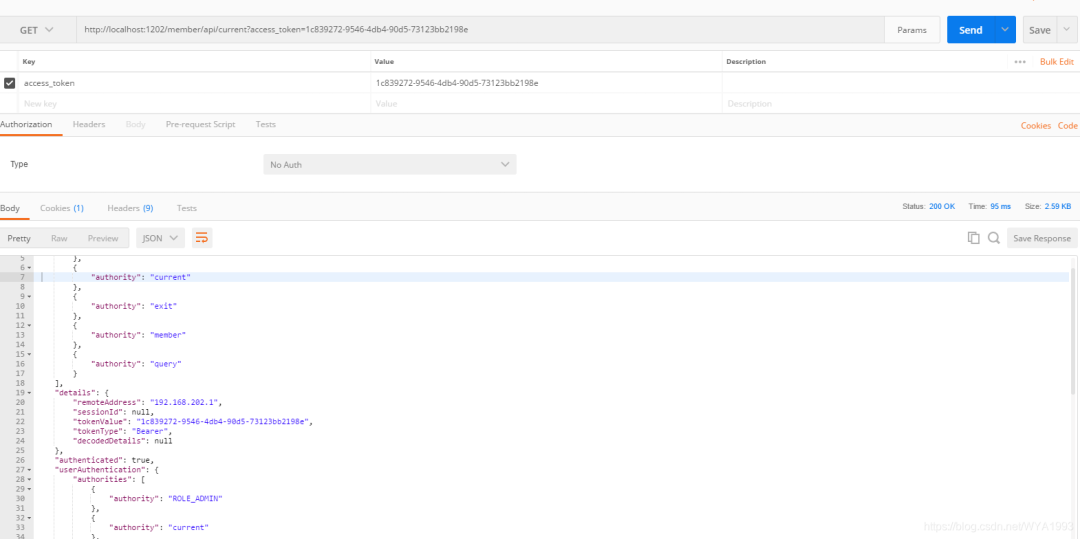
请求member服务的query接口

请求member服务的hello接口,数据库里并没有给用户hello权限

刷新token
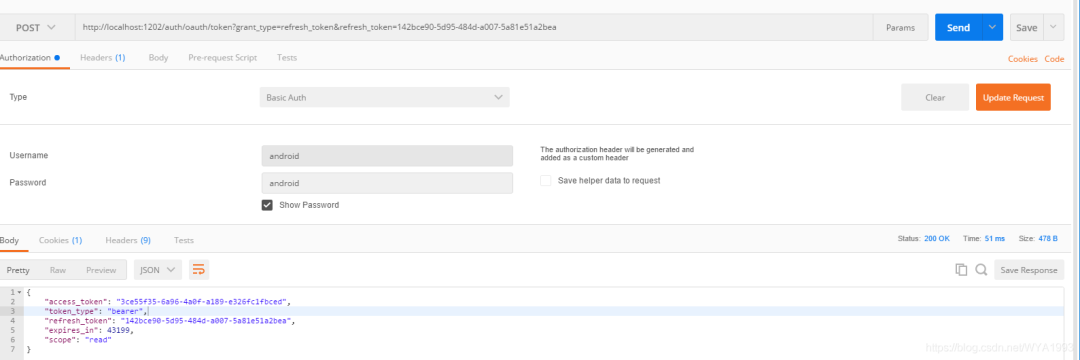
注销

后续还会慢慢完善,敬请期待!
关于代码和数据表sql已经上传到GitHub。地址:https://github.com/WYA1993/springcloud_oauth2.0。
注意把数据库和redis替换成自己的地址
获取认证时返回401,如下:
{
"timestamp": "2019-08-13T03:25:27.161+0000",
"status": 401,
"error": "Unauthorized",
"message": "Unauthorized",
"path": "/oauth/token"
}原因是在发起请求的时候没有添加Basic Auth认证,如下图:
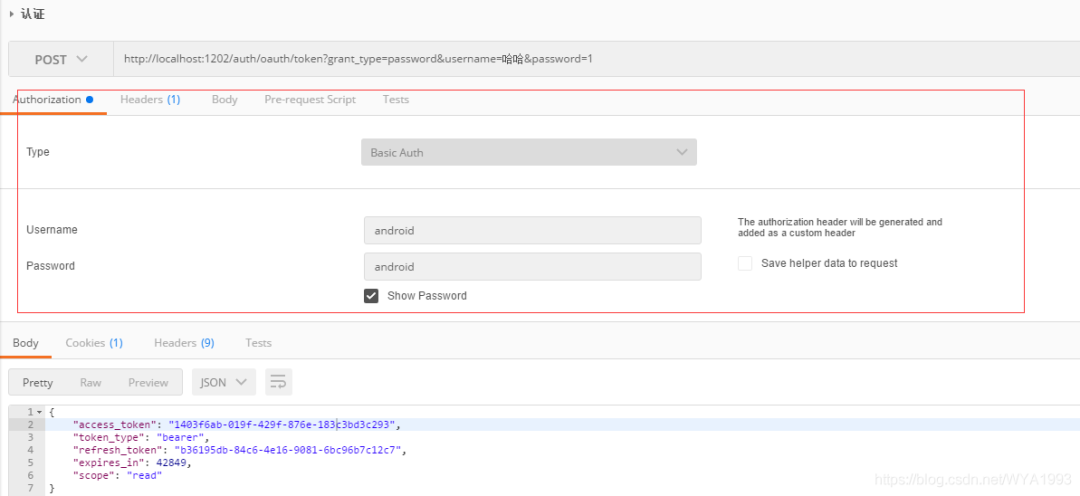
,添加Basic Auth认证后会在headers添加一个认证消息头

添加Basic Auth认证的信息在代码中有体现:

客户端信息和token信息从MySQL数据库中获取
现在客户端信息都是存在内存中的,生产环境肯定不可以这么做,要支持客户端的动态添加或删除,所以我选择把客户端信息存到MySQL中。
首先,创建数据表,数据表的结构官方已经给出,地址在
https://github.com/spring-projects/spring-security-oauth/blob/master/spring-security-oauth2/src/test/resources/schema.sql
create table oauth_client_details (
client_id VARCHAR(128) PRIMARY KEY,
resource_ids VARCHAR(256),
client_secret VARCHAR(256),
scope VARCHAR(256),
authorized_grant_types VARCHAR(256),
web_server_redirect_uri VARCHAR(256),
authorities VARCHAR(256),
access_token_validity INTEGER,
refresh_token_validity INTEGER,
additional_information VARCHAR(4096),
autoapprove VARCHAR(256)
);
create table oauth_client_token (
token_id VARCHAR(256),
token BLOB,
authentication_id VARCHAR(128) PRIMARY KEY,
user_name VARCHAR(256),
client_id VARCHAR(256)
);
create table oauth_access_token (
token_id VARCHAR(256),
token BLOB,
authentication_id VARCHAR(128) PRIMARY KEY,
user_name VARCHAR(256),
client_id VARCHAR(256),
authentication BLOB,
refresh_token VARCHAR(256)
);
create table oauth_refresh_token (
token_id VARCHAR(256),
token BLOB,
authentication BLOB
);
create table oauth_code (
code VARCHAR(256), authentication BLOB
);
create table oauth_approvals (
userId VARCHAR(256),
clientId VARCHAR(256),
scope VARCHAR(256),
status VARCHAR(10),
expiresAt TIMESTAMP,
lastModifiedAt TIMESTAMP
);
-- customized oauth_client_details table
create table ClientDetails (
appId VARCHAR(128) PRIMARY KEY,
resourceIds VARCHAR(256),
appSecret VARCHAR(256),
scope VARCHAR(256),
grantTypes VARCHAR(256),
redirectUrl VARCHAR(256),
authorities VARCHAR(256),
access_token_validity INTEGER,
refresh_token_validity INTEGER,
additionalInformation VARCHAR(4096),
autoApproveScopes VARCHAR(256)
);调整后的sql脚步也放到了GitHub中,需要的可以自行下载

然后在eshop_member数据库创建数据表,将客户端信息添加到oauth_client_details表中

如果你的密码不是明文,记得client_secret需要加密后存储。
然后修改代码,配置从数据库读取客户端信息

接下来启动服务测试即可。
获取授权
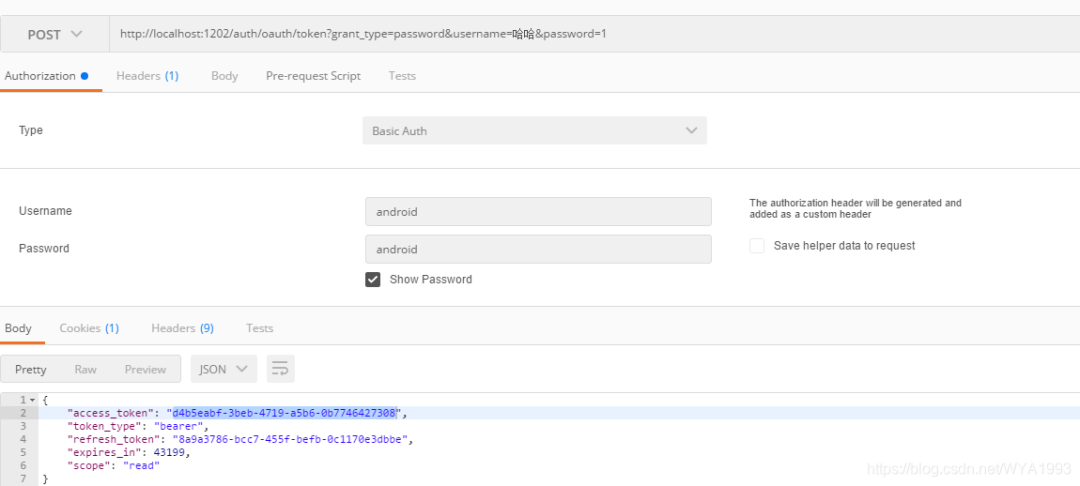
获取用户信息
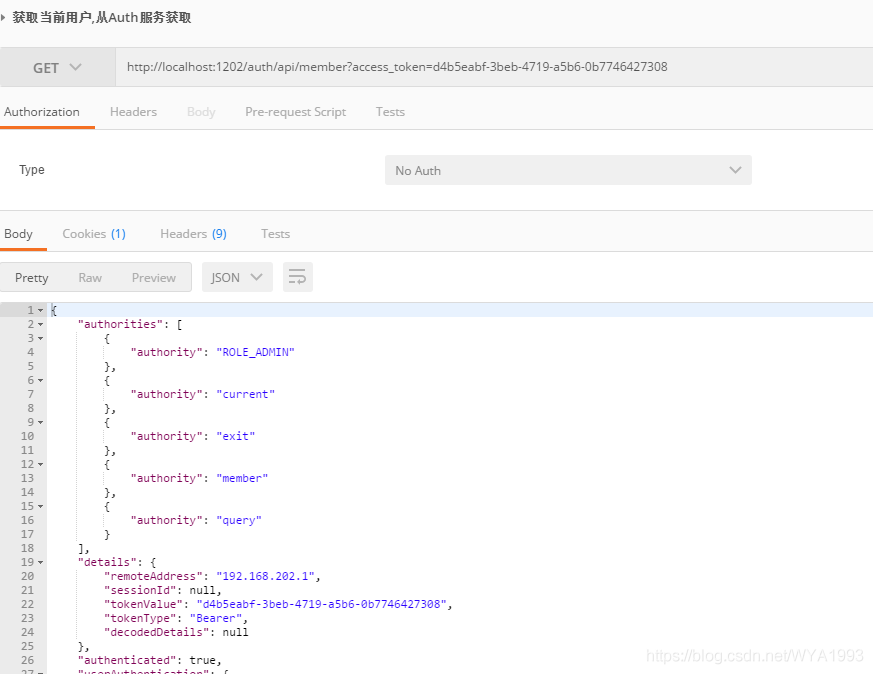
刷新token
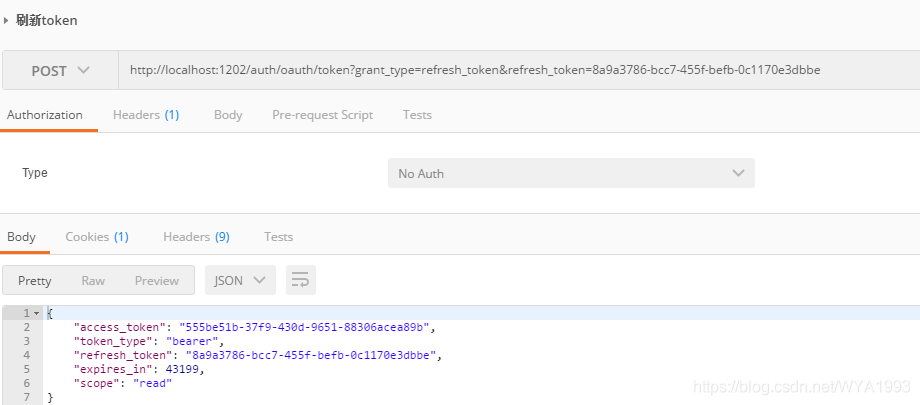
打开数据表发现token这些信息并没有存到表中,因为tokenStore使用的是redis方式,我们可以替换为从数据库读取。修改配置
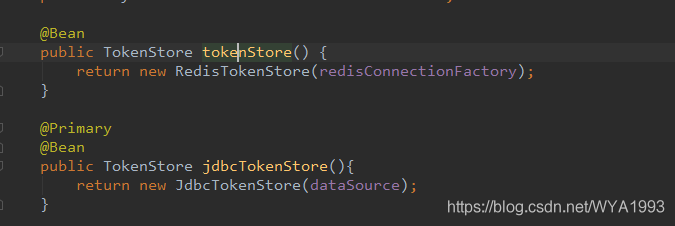
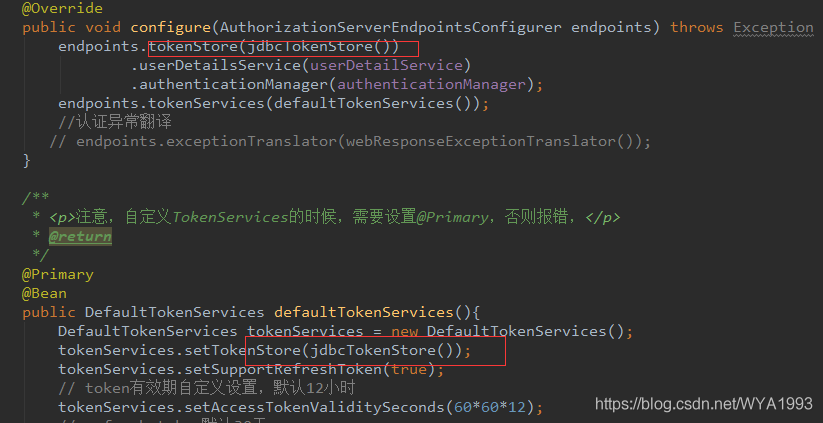
重启服务再次测试
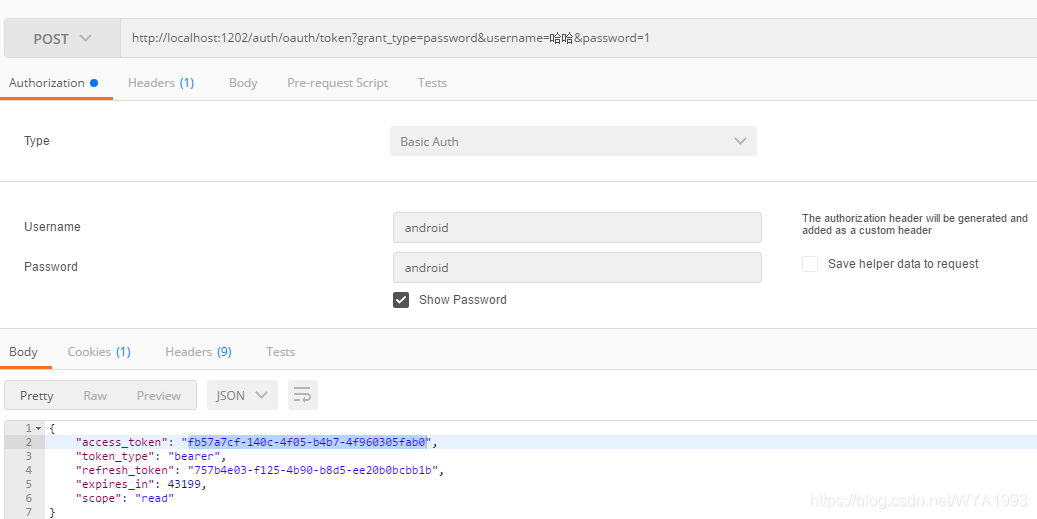

查看数据表,发现token数据已经存到表里了。


源码地址:https://github.com/WYA1993/springcloud_oauth2.0。 来自:CSDN,作者:myCat 链接:https://blog.csdn.net/WYA1993/article/details/85050120

